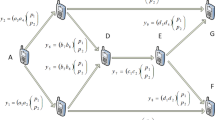Abstract
A tag encoding authentication scheme for network coding proposed by Wu et al was claimed to defend pollution attacks efficiently. However, we find that the scheme easily incurs multi-generation pollution attacks, where an adversary may be able to recover the main secret key of the source with high probability during multi-generation transmitting, and the scheme also cannot resist against inter-generation pollution attacks. Using a dynamic source secret key technology that the key can be updated with the change of generation identifier, an improved scheme is then presented, which can counteract these security defects without any efficiency compromise.
Similar content being viewed by others
References
Ahlswede R, Cai N, Li S-Y R, et al. Network information flow[J]. IEEE Transactions on Information Theory, 2000, 46(4):1204–1216.
Ho T, Médard M, Koetter R, et al. A random linear network coding approach to multicast[J]. IEEE Transactions on Information Theory, 2006, 52(10): 4413–4430.
Médard M, Sprintson A. Network Coding: Fundamentals and Applications[M]. New York: Academic Press, 2011.
Ho T, Leong B, Koetter R, et al. Byzantine modification detection in multicast networks using randomized network coding [J]. IEEE Transactions on Information Theory, 2008, 54(6): 2798–2803.
Jaggi S, Langberg M, Katti S, et al. Resilient network coding in the presence of Byzantine adversaries [J]. IEEE Transactions on Information Theory, 2008, 54(6): 2596–2603.
Koetter R, Kschischang F R. Coding for errors and erasures in random network coding [J]. IEEE Transactions on Information Theory, 2008, 54(8): 3579–3591.
Dong J, Curtmola R, Nita-Rotaru C. Practical defenses against pollution attacks in intra-flow network coding for wireless mesh networks [C] //Proceedings of the Second ACM Conference on Wireless Network Security. New York: ACM Press, 2009: 111–122.
Kim M J, Medard M, Barros J. Algebraic watchdog: mitigating misbehavior in wireless network coding [J]. IEEE Journal on Selected Areas in Communications, 2011, 29(10): 1916–1925.
Kehdi E, Li B. Null keys: Limiting malicious attacks via null space properties of network coding [C] // Proceedings of INFOCOM. Washington D C: IEEE Press, 2009: 1224–1232.
Gkantsidis C, Rodriguez P. Cooperative security for network coding file distribution [C] // Proceedings of INFOCOM. Washington D C: IEEE Press, 2006: 1–13.
Boneh D, Freeman D, Katz J, et al. Signing a linear subspace: Signature schemes for network coding [C] // Proceedings of Public Key Cryptography (PKC). Berlin: Springer-Verlag, 2009: 68–87.
Liu G, Wang B. Secure network coding against intra/ intergeneration pollution attacks [J]. China Communications, 2013, 10(8): 100–110.
Jiang Y, Zhu H, Shi M, et al. An efficient dynamic-identity based signature scheme for secure network coding [J]. Computer Networks, 2010, 54(1): 28–40.
Zhang P, Jiang Y, Lin C, et al. Padding for orthogonality: efficient subspace authentication for network coding [C] // Proceedings of INFOCOM. Washington D C: IEEE Press, 2011: 1026–1034.
Li Y, Yao H, Chen M, et al. RIPPLE Authentication for Network Coding [C] // Proceedings of INFOCOM. Washington D C: IEEE Press, 2010: 1–9.
Agrawa S, Boneh D. Homomorphic MACs: MAC-Based Integrity for Network Coding [C] // Proceedings of Applied Cryptography and Network Security. Paris: Springer-Verlag, 2009: 292–305.
Cheng C, Jiang T, Zhang Q. TESLA-based homomorphic MAC for authentication in P2P system for live streaming with network coding [J]. IEEE Journal on Selected Areas in Communications, 2013, 31(9): 291–298.
Newell A, Dong J, Nita-Rotaru C. On the practicality of cryptographic defences against pollution attacks in wireless network coding [J]. ACM Computing Surveys (CSUR), 2013, 45(3): 39.
Wu X, Xu Y, Yuen C, et al. A tag encoding scheme against pollution attack to linear network coding [J]. IEEE Transactions on Parallel and Distributed Systems, 2014, 25(1): 33–42.
Gohberg I, OlshevskyV. Fast algorithms with preprocessing for matrix-vector multiplication problems [J]. Journal of Complexity, 1994, 10(4): 411–427.
Author information
Authors and Affiliations
Corresponding author
Additional information
Foundation item: Supported by the National Natural Science Foundation of China (61271174, 61301178), the Specific Scientific Research Plan Project of Shaanxi Education Department (15JK2150) and the Science and Technology Innovation Foundation of Xi’an (CXY1352WL28, CXY1531WL38)
Rights and permissions
About this article
Cite this article
Liu, G. Security analysis and improvement of a tag encoding authentication scheme for network coding. Wuhan Univ. J. Nat. Sci. 21, 394–398 (2016). https://doi.org/10.1007/s11859-016-1186-1
Received:
Published:
Issue Date:
DOI: https://doi.org/10.1007/s11859-016-1186-1




